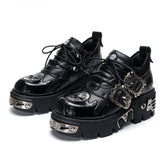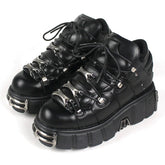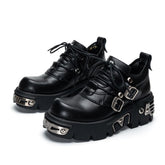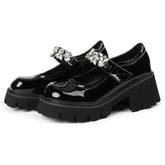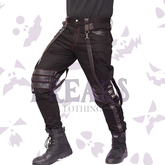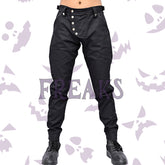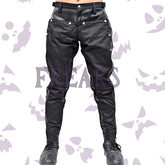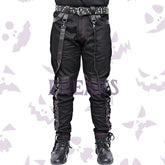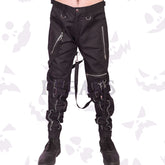From Victorian Shadows to the Modern Era: The History of Gothic Fashion
Gothic fashion is a striking and enduring subculture that blends dark elegance, historical influences, and modern rebellion into a style that’s both timeless and evolving. From its roots in the Victorian era’s fascination with the macabre to its contemporary expressions in punk, cyber-goth, and steampunk aesthetics, gothic fashion has captivated generations with its dramatic silhouettes, rich textures, and unapologetic individuality. In 2025, gothic fashion continues to thrive, offering a diverse range of styles that appeal to enthusiasts of all backgrounds. This comprehensive exploration traces the history of gothic fashion from its Victorian origins to its modern manifestations, highlighting key influences, iconic garments, and its cultural significance, brought to you by Freaks Clothing Shop.
The Victorian Roots of Gothic Fashion (1800s)
Gothic fashion finds its earliest inspiration in the Victorian era (1837–1901), a period marked by a fascination with death, romance, and the supernatural. The term “gothic” originally referred to medieval architecture and literature, evoking dark, mysterious, and ornate aesthetics. For more understanding about gothic fashion have a look on Ultimate guide to gothic fashion styles. During the Victorian period, this translated into fashion through mourning attire, which became a cultural norm following Queen Victoria’s prolonged mourning of Prince Albert’s death in 1861.
Key Features of Victorian Gothic Fashion
- Mourning Attire: Black dresses, veils, and suits made from heavy fabrics like crepe, silk, and velvet were worn to signify grief, establishing black as a cornerstone of gothic style. Have a look on our Victorian tailcoat.
- Ornate Details: High collars, lace trim, corsets, and ruffled shirts added elegance and drama, reflecting the era’s opulent tailoring.
- Silhouettes: Long, flowing frock coats, tailcoats, and bustled dresses created a structured yet romantic silhouette, influencing modern gothic coats.
- Accessories: Cameo jewelry, pocket watches, and parasols added sophistication, while jet beads and mourning pins emphasized the macabre.
Victorian gothic fashion was not just about mourning; it was also influenced by gothic literature, such as Mary Shelley’s Frankenstein and Bram Stoker’s Dracula. These works fueled a cultural obsession with the supernatural, which manifested in clothing that evoked mystery and elegance. This laid the foundation for the gothic subculture, with its emphasis on dark beauty and emotional expression.

The Birth of the Modern Gothic Subculture (1970s–1980s)
While the Victorian era set the stage, modern gothic fashion emerged in the late 1970s and early 1980s as a subcultural movement tied to the post-punk music scene in the United Kingdom. Bands like Bauhaus, Sioux Sie and the Banshees, and The Sisters of Mercy pioneered the gothic rock genre, blending punk’s rebellion with a darker, more theatrical aesthetic. Fans adopted their style, creating what we now recognize as the gothic subculture.
Key Influences and Characteristics
- Post-Punk Aesthetic: Black clothing, leather jackets, and fishnet shirts became staples, inspired by punk’s DIY ethos but with a darker, moodier twist.
- Victorian Revival: Elements like lace, velvet, and corsets were reintroduced, drawing from Victorian mourning attire but with a modern, rebellious edge.
- Makeup and Hair: Pale foundation, dark eyeliner, and teased or dyed black hair became iconic, emphasizing a dramatic, otherworldly look.
- Subcultural Identity: Goths embraced individuality and non-conformity, using fashion to express existential themes and reject mainstream trends.
Read Also: How to Style Punk Clothing for a Bold Look
By the 1980s, gothic fashion was distinct from punk, with iconic venues like London’s Batcave club serving as hubs for the subculture. The gothic look was characterized by black leather jackets, ripped fishnets, band tees, and combat boots, often accessorized with silver jewelry, crosses, and ankh pendants.
The Evolution of Gothic Fashion (1990s–2000s)
The 1990s and 2000s saw gothic fashion diversify as the subculture gained mainstream visibility through music, film, and media. Movies like The Crow (1994) and The Matrix (1999) popularized long black trench coats and leather, while bands like Marilyn Manson and Evanescence brought gothic style to a broader audience. This period also saw the rise of subgenres within gothic fashion, each adding unique elements to the aesthetic.
Key Subgenres and Developments
- Industrial Goth: Influenced by industrial music, this style incorporated metallic accessories, PVC, and cyber-inspired elements like neon accents and reflective fabrics. Have a look on our industrial slim fit pants.
- Victorian Goth: A return to 19th-century elegance, with frock coats, corsets, and lace-up boots becoming popular for formal gothic looks.
- Cyber Goth: Emerging in the late 1990s, this subgenre blended gothic with rave culture, featuring bright neon colors, platform boots, and futuristic accessories like goggles.
- Nu-Goth: A minimalist take on gothic fashion, focusing on simple black clothing, geometric jewelry, and modern silhouettes, popular in the 2000s.

During this period, gothic fashion became more accessible through alternative clothing brands and online retailers. The internet allowed goths worldwide to connect, share DIY fashion tips, and discover new styles, further diversifying the subculture.
Modern Gothic Fashion (2010s–2025)
In the 2010s and 2020s, gothic fashion continued to evolve, embracing sustainability, inclusivity, and cross-cultural influences while maintaining its core aesthetic. Social media platforms like Instagram and TikTok have played a significant role in spreading gothic fashion, with influencers showcasing everything from high-end couture to DIY punk looks. In 2025, gothic fashion is more diverse than ever, blending traditional elements with contemporary trends and subgenres like steampunk, emo, and dark academia.
Key Trends in 2025
- Sustainable Materials: Eco-friendly fabrics like vegan leather, recycled cotton, and organic wool are gaining popularity, reflecting a growing emphasis on ethical fashion.
- Hybrid Aesthetics: Gothic fashion is merging with other subcultures, such as steampunk (brass buttons, goggles), dark academia (tweed blazers, bookish accessories), and cyber-goth (neon accents, PVC).
- Gender-Neutral Styles: Modern gothic fashion embraces inclusivity, with unisex designs like oversized coats, layered tops, and tailored trousers appealing to all genders.
- Minimalist Goth: A continuation of nu-goth, this style focuses on sleek black outfits, subtle accessories, and modern cuts for a refined look.
-
High-Fashion Influence: Designers like Alexander McQueen and Rick Owens have brought gothic elements to haute couture, with dramatic silhouettes and dark palettes influencing mainstream fashion.
Iconic Garments in Modern Gothic Fashion
Coats and Jackets: Long trench coats, military-inspired coats, and punk leather jackets remain staples, often adorned with studs, buckles, or high collars.
Corsets and Vests: Corsets are worn by all genders, paired with waistcoats or layered under coats for a Victorian-inspired look. Have a look on Gothic Vests ideas.
Boots: Combat boots, platform boots, and lace-up Victorian boots are essential for completing the gothic silhouette.
Accessories: Chokers, silver rings, ankh pendants, and spiked bracelets add personality and edge.

Cultural Significance of Gothic Fashion
Gothic fashion is more than just clothing; it’s a form of self-expression that challenges societal norms and celebrates individuality. The subculture provides a space for those who feel drawn to themes of darkness, introspection, and rebellion, offering a sense of community and belonging. Gothic fashion also intersects with art, music, and literature, creating a rich cultural tapestry that continues to inspire creatives worldwide.
In 2025, gothic fashion remains a powerful way to reject conformity and embrace personal identity. Its versatility allows it to adapt to modern trends while staying true to its roots in Victorian elegance and punk rebellion. Whether you’re drawn to the opulence of a frock coat or the raw energy of a leather jacket, gothic fashion offers endless possibilities for self-expression.
Styling Gothic Fashion in 2025
To embrace gothic fashion for your wardrobe, consider these tips:
Layering: Combine corsets, vests, or lace shirts under a long coat for depth and texture. Add a scarf or shawl for winter warmth.
Footwear: Combat boots, platform shoes, or Victorian lace-ups complement gothic outfits, adding height and attitude.
Accessories: Silver jewelry, chokers, or pocket watches enhance the aesthetic, while makeup like dark eyeliner or pale foundation adds drama. For more amazing styling styling check our blog on how to accessories gothic outfits now for amazing looks.
Color Palette: Stick to black as the base, with accents in deep red, purple, or metallic tones for variety.
Where to Find Gothic Fashion
For an exceptional selection of gothic clothing, visit Freaks Clothing Shop. Our 2025 collection features handcrafted pieces inspired by the rich history of gothic fashion, from Victorian frock coats to punk leather jackets. Crafted with premium materials like velvet, wool, and faux leather, our garments embody the subculture’s dark elegance and rebellious spirit. Explore Freaks Clothing Shop to find the perfect pieces to elevate your gothic wardrobe.
FAQs
Q: What is the origin of gothic fashion?
A: Gothic fashion originated in the Victorian era’s mourning attire and evolved in the 1970s–1980s through the post-punk music scene, influenced by bands like Bauhaus and Siouxsie and the Banshees.
Q: How has gothic fashion changed over time?
A: It has diversified from Victorian-inspired looks to include subgenres like industrial, cyber-goth, and nu-goth, incorporating sustainable materials and modern cuts in 2025.
Q: Can gothic fashion be worn daily?
A: Yes, minimalist styles like nu-goth or casual pieces like leather jackets and boots are versatile for everyday wear, while ornate coats suit events.
Q: How do I care for gothic clothing?
A: Dry clean or gently wash wool and velvet; clean faux leather with a damp cloth and conditioner. Store on padded hangers to maintain shape.
Q: Where can I find authentic gothic clothing?
A: Freaks Clothing Shop offers a curated selection of gothic garments, from Victorian-inspired coats to modern punk jackets, crafted for 2025-26 enthusiasts.
Conclusion
From its Victorian roots in mourning attire to its modern iterations in punk, cyber-goth, and steampunk aesthetics, gothic fashion has evolved into a vibrant subculture that celebrates dark beauty and individuality. In 2025, it continues to thrive, blending historical elegance with contemporary innovation to offer something for every enthusiast. Whether you’re drawn to the opulence of a frock coat or the rebellion of a leather jacket, gothic fashion invites you to express your unique identity. Visit Freaks Clothing Shop to explore our exclusive collection of gothic clothing, designed to honor the subculture’s rich history while embracing its modern evolution. Step into the shadows and make your mark with gothic style.

